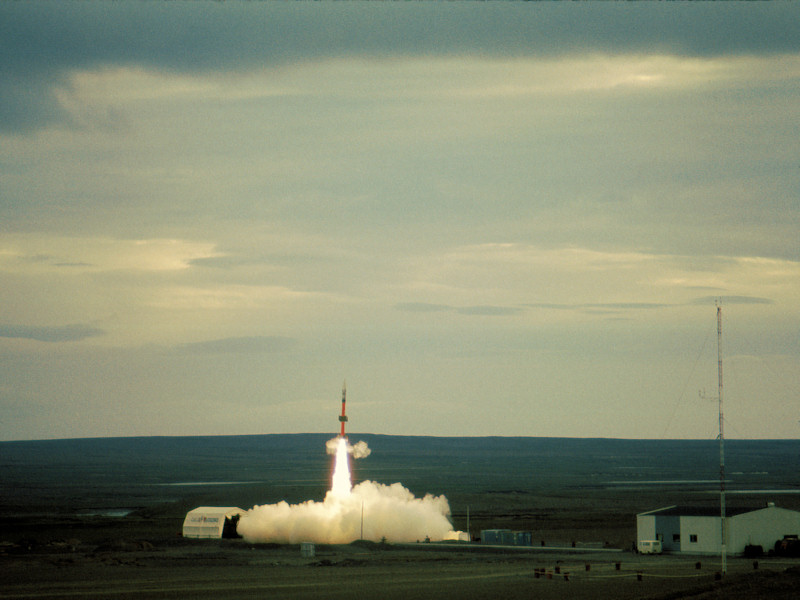Photo
album: "ARAKS: Second launch"
Fly
over a photo with the mouse to enlarge it
Click
on a photo to open it in a new window
A
new waiting period has begun after the first launch. On February 3rd
1975, an ARCAS rocket is launched and shows that all the required conditions for
an ARAKS launch are not met. The same day, Marion Dufresne, who arrived on
February 1st evening, leaves. All
the conditions for a second ARAKS launch are met only on February 15th.
The Soviet ship Borovici who has completed her mission, leaves Golf of Morbihan
on February 19th..
On February 21st, Marion Dufresne makes a short call at
Port-aux-Français. On February 25th Kudrevic, another Soviet ship,
arrives. She comes to fetch the different scientific teams who have participated
in the ARAKS campaign. She leaves on March 2nd. In the meantime the
Géophy team goes on with its works, amongst which is the modernization of the
ionosonde. Our campaign ends on March 17th, we embark on Marion
Dufresne who leaves, heading to Réunion island.
 |
On Saturday February 15th
1975, the conditions for a second ARAKS launch are finally met. |
 |
A first ARCAS rocket is launched.
|
 |
A few minutes later, a second ARACS
rocket has taken off. |
 |
At 7:36 am the Eridan rocket takes
off with a deafening noise. |
 |
The main receiving and tracking
antenna is operational. |
 |
The backup antenna is ready to take
over if necessary. |
 |
Inside the Géophy laboratory, the
Soviet scientist observes its instruments. |
 |
Bernard Morlet is checking the
geophysical activity at the ground level. He is helped by Alain Lamalle,
who spent the winter over with me in Dumont d'Urville in 1967 and who is
now working with the scientific office of the French Southern and
Antarctic Territories. |
 |
After the launch, Jean-Yves
Delahaye, from the GRI's ARAKS scientific team, retrieves the different
graphical checkup recordings of the experiment. |
 |
This is what is left of the first
stage of the Eridan rocket after it fell down onto the earth. The second
stage and the ejectable nose cone fell down into the sea. |
 |
The whole body of the first stage
of the rocket has folded up like an accordion at the moment of impact with
the ground. |
 |
On March 2nd 1975, all
the ARAKS materiel has been loaded into the soviet ship Kudrevic. The
Soviet, American and French scientific teams are leaving us. |
 |
On the pier, all the people who are leaving and the ones who accompany
them are waiting for the barge. |
 |
The Soviet cineaste is filming the
departure. |
 |
On the barge which is moving away
from the pier, the leaving people are waving a last hello. |
 |
Kudrevic is sailing away. |
 |
Our departure is drawing near and,
taking advantage of a fine weather, we are taking a last Sunday walk. |
 |
This discarded tractor belonged to the SIDAP company and was used to
transport the elephant seal carcasses to the processing plant. |
 |
However years have passed by and
the elephant seals have no longer to fear from the men who come and visit
them. They are protected as well as the whole autochthon fauna. This male elephant
seal is impressive enough and I am sure I fail to come up to
weight with it. Therefore I am prudently staying at a safe distance. |
 |
We are watching for the last time
the sun setting over Kerguelen. Tomorrow we will embark onto Marion
Dufresne. |
 |
On Monday March 17th 1975, different kinds of materiel are
loaded onto the barges in order to be embarked into Marion Dufresne. |
 |
In the afternoon, we are watching
the moving away pier, where people who are going to spend the austral
winter in Kerguelen are busying themselves. When we arrive at Réunion
island, six months will have passed by since I left France. |
Go
back
.
.
.
.
.
.
.



















